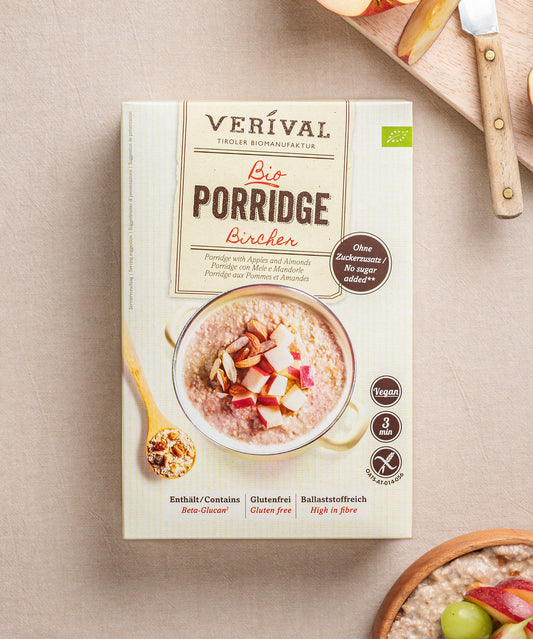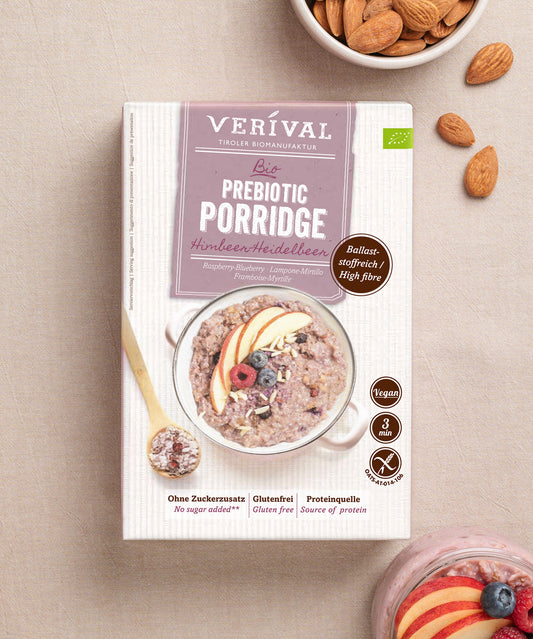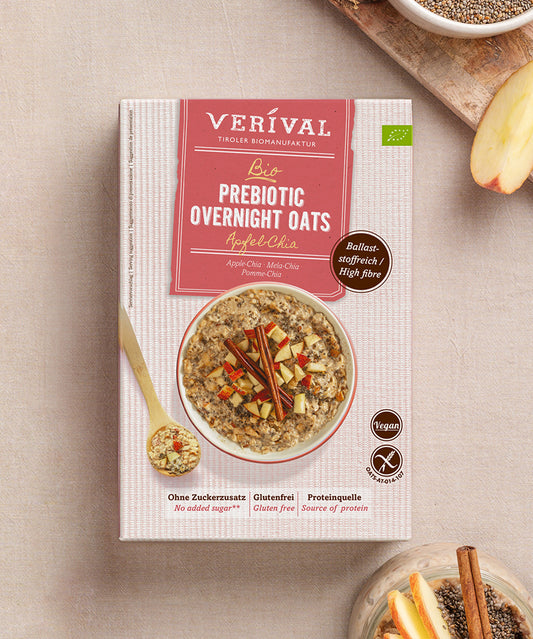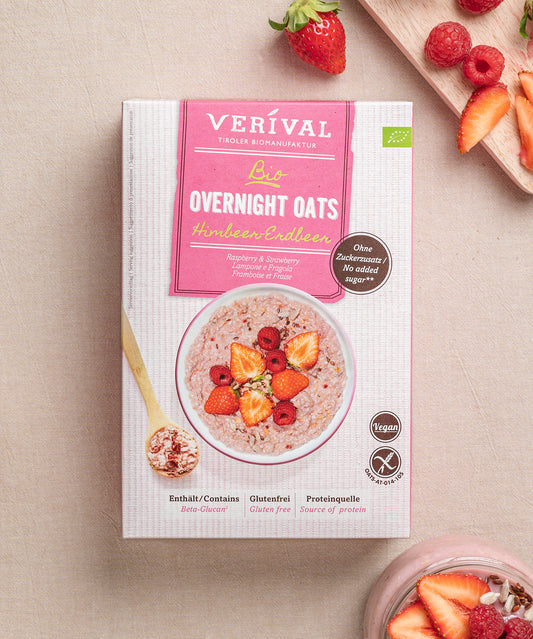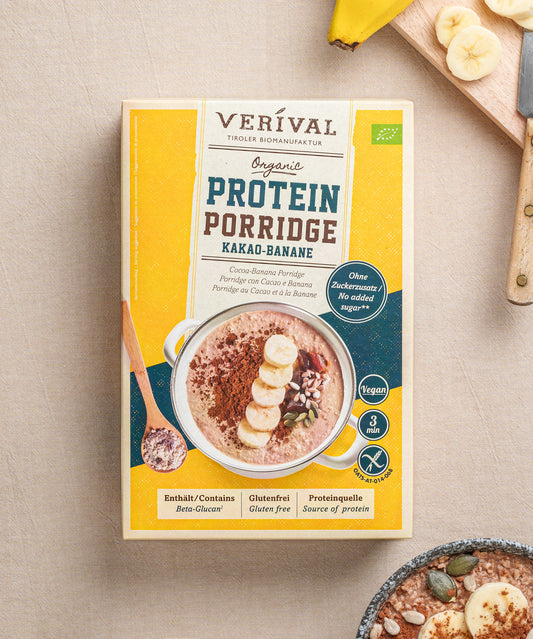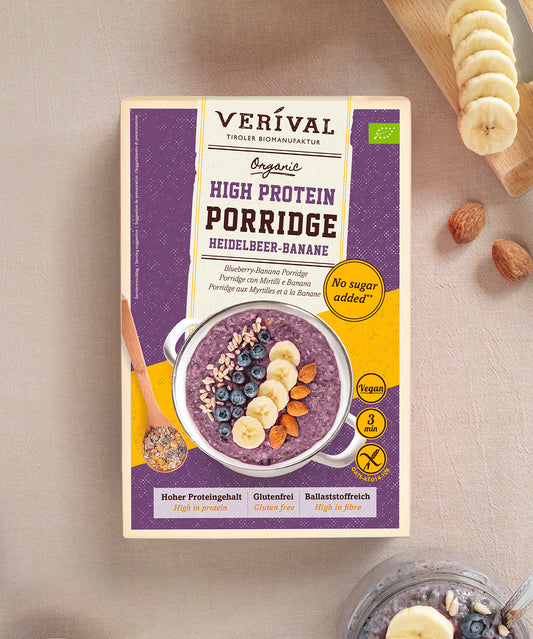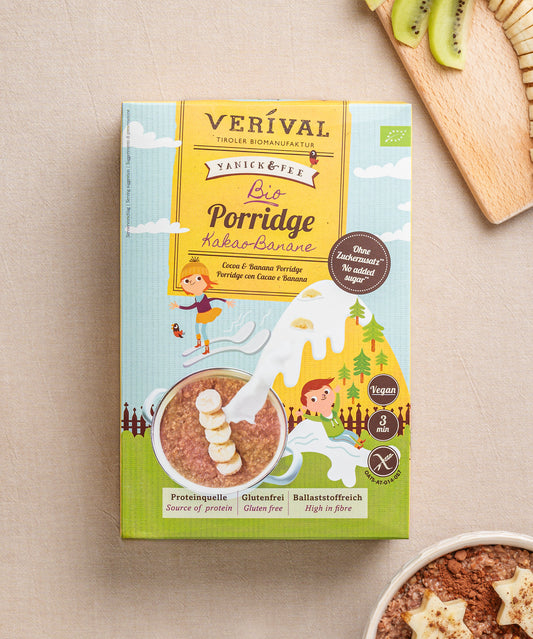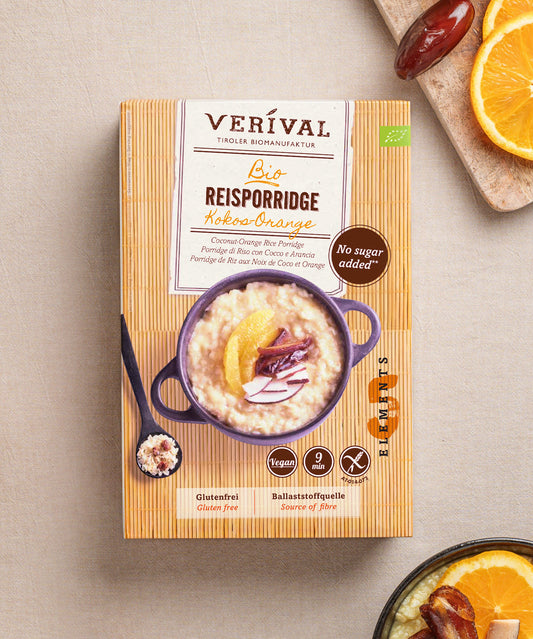A high-fiber diet plays an important role in our health. But what exactly is high-fiber food and why is it so important? Dietary fiber is a complex carbohydrate found in plant-based foods that cannot be completely digested by the body. Fiber is considered a “ballast,” but this term is misleading because it offers a range of health benefits.
A high-fiber diet involves eating foods that are high in fiber. A balanced diet with a variety of plant-based foods such as vegetables, fruit, whole grains, legumes and nuts provides a good amount of fiber. In today's blog post, we provide an overview of the different types of fiber, what effect they have and how you can best incorporate them into your diet.
Discover high-fiber Verival Porridge here
Types of fiber
There are different types of fiber in our diet. There are two types of fiber: soluble and insoluble. In the following, we will explain exactly how they work and what functions they have in our body.
Soluble fiber
Soluble dietary fiber is an important component of a high-fiber diet. It is characterized by being soluble in water and forming a gel-like substance. But what exactly is soluble fiber and what are its functions and benefits?
Soluble fiber is a complex carbohydrate that cannot be fully digested by the body. They reach the large intestine unchanged, where they are fermented by the resident bacteria. During the fermentation process, these bacteria produce short-chain fatty acids, which play an important role in intestinal health.
One of the main functions of soluble fiber is to bind water and form a gel-like consistency. This property helps to regulate digestive function by improving stool consistency and preventing constipation. In addition, soluble fiber has a positive influence on blood sugar levels by slowing its rise after a meal. This can help reduce the risk of diabetes.
There are many sources of soluble fiber in the diet. Foods such as oats, barley, legumes, apples, berries, flaxseeds and chia seeds are high in soluble fiber. By regularly including these fiber-rich foods in our diet, we can increase our intake of soluble fiber and benefit from its many health advantages.
Insoluble fiber
Insoluble fiber is an important component of a high-fiber diet. Unlike soluble fiber, it does not dissolve in water and increase stool volume. But what exactly is insoluble fiber, and what are its functions and benefits?
Insoluble dietary fiber is indigestible carbohydrates that pass through the gastrointestinal tract largely unchanged. They promote gut health by increasing stool volume and stimulating intestinal motility. This helps to prevent constipation and promotes regular bowel movements. Insoluble fiber also has a certain satiating effect and can help support weight management.
A sufficient intake of insoluble fiber is important, and there are various sources from which we can find it in our diet. Whole grain products such as whole grain bread, oat flakes, brown rice and whole grain pasta are rich in insoluble fiber. Vegetables such as broccoli, carrots and celery, as well as nuts and seeds such as almonds, walnuts and flaxseeds, are also good sources of insoluble fiber.
By including a variety of high-fiber foods in our diet, we can ensure that we consume sufficient amounts of insoluble fiber. This allows us to benefit from the functions and advantages they offer, such as improved intestinal health and weight management support.
Resistant starch
Resistant starch is a special form of starch that offers a range of functions and benefits for our health. But what exactly is resistant starch and what significance does it have in our diet?
Resistant starch is a form of starch that is not fully digested by the body. Unlike other forms of starch, resistant starch reaches the large intestine, where it is fermented by the bacteria that live there. During the fermentation process, short-chain fatty acids are produced, which have positive effects on gut health.
The functions and benefits of resistant starch are diverse. One of them is its role in promoting the growth and activity of healthy intestinal bacteria. These healthy bacteria are important for a balanced intestinal flora and help to support the immune system. Resistant starch can also help to stabilize blood sugar levels and improve insulin sensitivity, which is particularly beneficial for people with diabetes.
There are various sources of resistant starch in the diet. The most common sources include legumes such as beans, lentils and chickpeas, green bananas, oatmeal, potatoes (cooked and then chilled), whole grains, and certain types of rice such as black rice and basmati rice.
Health benefits of a high-fiber diet
A high-fiber diet offers a wide range of health benefits. Incorporating high-fiber foods into our daily diet can lead to improved health and well-being in the long term.
Digestive health: high-fiber foods as gut supporters
Digestive health plays a crucial role in our well-being and overall health. A high-fiber diet can have a positive impact on digestion and prevent various digestive problems.
A high-fiber diet helps prevent both constipation and diarrhea. Fiber increases stool volume and improves intestinal motility. This makes it easier for stool to pass through the digestive tract and helps prevent constipation. On the other hand, fiber can bind excess fluid in the intestines and promote a firmer stool consistency in the event of diarrhea.
In addition, a high-fiber diet supports intestinal health. Dietary fiber serves as food for the beneficial bacteria in the gut, which contributes to a balanced gut flora. A healthy gut flora is important for optimal digestion and the absorption of nutrients. In addition, dietary fiber promotes the formation of short-chain fatty acids in the gut, which can support gut health and have an anti-inflammatory effect.
To benefit from the positive effects on digestive health, it is important to include high-fiber foods in your diet. Fruits, vegetables, whole grains, legumes and nuts are excellent sources of fiber. It is recommended to consume about 25 to 30 grams of fiber daily.
Fiber-rich food for a healthy gut
High-fiber foods for perfect weight management
A high-fiber diet can be a valuable aid to weight management. Fiber plays an important role in creating a long-lasting feeling of satiety and reducing the feeling of hunger.
Dietary fiber has a high filling capacity and takes longer to digest. This prolongs the feeling of satiety and we are less inclined to snack or overeat between meals. By eating foods high in fiber, we can stay full longer and reduce our overall calorie intake.
In addition, high-fiber foods often contain fewer calories compared to processed and sugary foods. Swapping these high-calorie options for high-fiber alternatives can reduce overall energy intake, which can lead to weight loss in the long term.
A high-fiber diet also supports the metabolism. Fiber increases the thermic effect of food, which means that the body uses more energy to digest and metabolize fiber. This can slightly increase energy expenditure.
To benefit from the advantages of a high-fiber diet in weight management, we should include high-fiber foods such as whole grains, vegetables, fruits, legumes and nuts in our meals. It is recommended to consume about 25 to 30 grams of fiber daily.
With Verival Breakfast, the right start to the day
A high-fiber diet for a healthy cardiovascular system
A high-fiber diet has a positive influence on the cardiovascular system and can help to reduce the risk of heart disease. In particular, the reduction of cholesterol levels plays an important role.
Dietary fiber, especially soluble fiber, binds to cholesterol in the digestive tract and aids in its excretion. Regular consumption of high-fiber foods can lower cholesterol levels. High blood cholesterol is a risk factor for developing heart disease, including atherosclerosis and heart attack.
In addition, a high-fiber diet helps improve overall heart health. Fiber can stabilize blood pressure and reduce inflammation in the body, which is also associated with an increased risk of heart disease.
Including more high-fiber foods in your diet, such as whole grains, legumes, fruits and vegetables, can help support cardiovascular health. A high-fiber diet should be considered part of an overall healthy lifestyle that includes regular physical activity, adequate hydration and avoiding harmful habits such as smoking.
Blood sugar control with a high-fiber diet
A high-fiber diet plays an important role in controlling blood sugar levels and can help reduce the risk of diabetes. Dietary fiber has a positive influence on blood sugar metabolism and can help prevent and stabilize blood sugar.
Dietary fiber slows the absorption of glucose from food, thus preventing a rapid rise in blood sugar levels after meals. It promotes a slower and more even release of glucose into the bloodstream. This helps you to keep your blood sugar levels more stable and avoid fluctuations.
A high-fiber diet can also reduce the risk of developing type 2 diabetes. Studies have shown that people who regularly consume high-fiber foods have a lower risk of developing diabetes than those who prefer low-fiber diets.
In addition, a high-fiber diet can help to better control blood sugar levels in people with diabetes. Fiber can reduce insulin resistance and improve the sensitivity of cells to insulin. This facilitates the uptake of glucose into cells and supports the regulation of blood sugar.
How Verival helps make your high-fiber diet easier
At Verival, we have made it our mission to make your mornings as perfect as possible. Whether you are an athlete or just want to take care of your health, we have something for everyone in our range.
Verival's high-fiber products
It is really important to us that you have absolute control over your breakfast. If you want a breakfast with lots of fiber, you've come to the right place. Whether it's muesli, porridge or our crunchy, there are many ways to incorporate fiber into your diet. Ideally, you should do it at breakfast time!
Discover all our Verival products with fiber and more high-fiber recipes now:
The Verival fiber products - discover them here
Conclusion: high-fiber food
A high-fiber diet offers numerous health benefits. Fiber is essential for good digestive health and can prevent constipation and diarrhea. It also supports intestinal health and promotes healthy intestinal flora. In addition, fiber plays an important role in weight management because it can provide long-lasting satiety and reduce hunger. A high-fiber diet can also reduce the risk of heart disease by regulating cholesterol levels and supporting the cardiovascular system. It also helps control blood sugar levels and can reduce the risk of diabetes.
To reap the benefits of a high-fiber diet, we should diversify our diet with high-fiber foods such as whole grains, legumes, fruits and vegetables. A balanced diet rich in fiber is part of a healthy lifestyle that includes regular physical activity and avoiding harmful habits.
By including high-fiber foods in our diet, we can lay the foundation for better health and enjoy the many long-term benefits of a high-fiber diet.
Frequently asked questions
What is fiber?
Fiber is a non-digestible carbohydrate found in plant-based foods. It is divided into soluble and insoluble fiber. Dietary fiber promotes intestinal health, regulates digestion and has a positive effect on blood sugar levels. A high-fiber diet is therefore important for good health.
Do oats or porridge contain a lot of fiber?
Yes, oats and porridge are high in fiber. Oats contain both soluble and insoluble fiber, with a higher amount of soluble fiber. A bowl or plate of porridge can provide a significant amount of fiber, which can help promote digestive health and provide long-lasting satiety. It is therefore a good option for supporting a high-fiber diet.
Where is the most fiber found?
Fiber is mainly found in plant-based foods. Whole grains, legumes, vegetables, fruits, nuts, and seeds are particularly high in fiber. A balanced diet with a variety of these foods helps to meet your fiber needs and reap the health benefits.
Which foods are high in fiber?
High-fiber foods include oatmeal, whole wheat bread, legumes, fruits, vegetables, nuts and seeds, and whole wheat pasta and rice. By incorporating these foods into your diet, you can increase your fiber intake. It is important to consume a variety of these high-fiber foods to reap their health benefits.
What is the ideal high-fiber breakfast?
An ideal high-fiber breakfast consists of oats as a base, fresh fruit for natural sweetness, and nuts or seeds for added fiber and healthy fats. You can supplement it with unsweetened yogurt and vary it with spices as you like. This meal promotes healthy digestion and provides nutrients for an energetic start to the day.
Is fiber good for your gut?
Fiber is good for your gut because it aids digestion and prevents constipation. It provides food for healthy gut bacteria and supports a balanced gut flora. By regularly consuming high-fiber foods, you can improve your gut health and reduce your risk of developing gut issues.
Does fiber increase your sense of well-being?
Fiber can improve well-being by regulating digestion and preventing constipation. It provides long-lasting satiety and supports stable blood sugar control, which contributes to more balanced energy levels. Overall, fiber-rich foods contribute to improved well-being.



